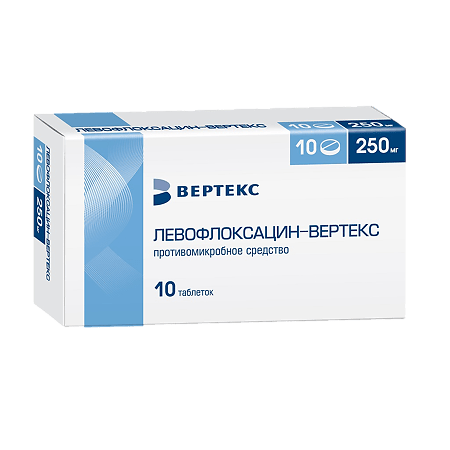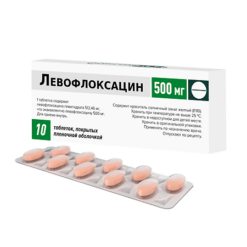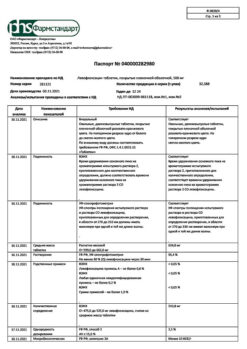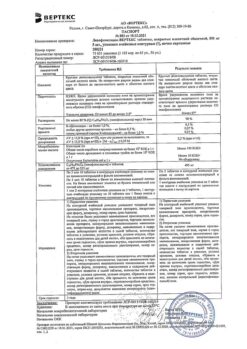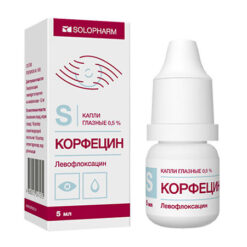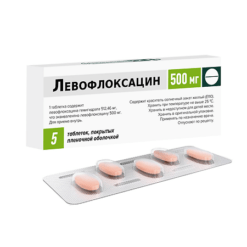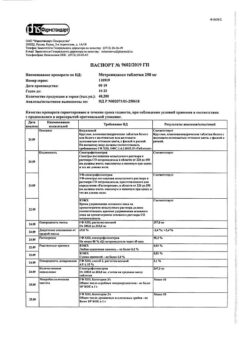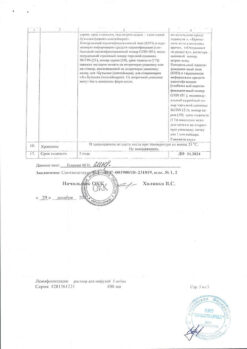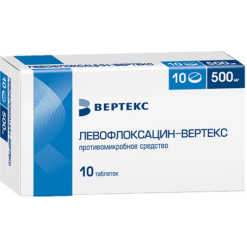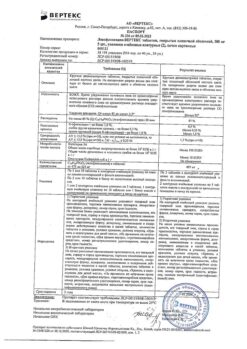No products in the cart.
Levofloxacin-Vertex, 250 mg 10 pcs
€9.47 €7.89
Out of stock
(E-mail when Stock is available)
Description
Pharmacotherapeutic group:
An antimicrobial agent, fluoroquinolone.
ATC code:
[J01MA12].
Pharmacological properties
Pharmacodynamics
Levofloxacin is a synthetic broad-spectrum antibacterial drug from the group of fluoroquinolones, probably as the active substance levofloxacin – the left-handed isomer ofloxacin.
Levofloxacin blocks DNA-giase, causes superspiralization and cross-linking of DNA breaks, inhibits DNA synthesis and causes morphological changes in cytoplasm, cell wall and membranes.
Levofloxacin is active against most strains under in vitro as well as in vivo conditions. Aerobic Gram-positive microorganisms: Corynebacterium diphtheriae, Enterococcus faecalis, Enterococcus spp, Listeria monocytogenes, Staphylococcus coagulazonegative methi-S(I), Staphylococcus aureus methi-S, Staphylococcus epidermidis methi-S, Staphylococcus spp (CNS), Streptococci group C and G, Streptococcus agalactiae, Streptococcus pneumoniae peni I/S/R, Streptococcus pyogenes, Viridans streptococci peni-S/R. Aerobic gram-negative microorganisms: Acinetobacter baumannil, Acinetobacter spp, Actinobacillus actinomycetemcomitans, Citrobacter freundii, Eikenella corrodens, Enterobacter aerogenes, Enterobacter agglomerans, Enterobacter cloacae, Enterobacter spp, Escherichia coli, Gardnerella vaginalis, Haemophilus ducreyi/Ampi-R ducreyi, Haemophilus influenza. Haemophilus parainfluenzae, Helicobacter pylori, Klebsiella oxytoca, Klebsiella pneumoniae, Klebsiella spp, Moraxela catarrhalis β+/β-, Morganella morganii, Neisseria gonorrhoeae non PPNG/PPNG, Neisseria meningitidis, Pasteurella conis, Pasteurella dagmatis, Pasteurella multocida, Pasteurella mirabili, Proteus mirabili , Proteus vulgaris, Providencia rettgeri, Providencia stuartii, Providencia species, Pseudomonas aeruginosa, Pseudomonas species, Salmonella species, Serratia marcescens species, Serratia species.
Anaerobic microorganisms: Bacteroides fragilis, Bifidobacterium spp, Clostridium perfringens, Fusobacterium spp, Peptostreptococcus, Propionibacterum spp, Veilonella spp. Other microorganisms: Bartonella spp, Chlamydia pneumoniae, Chlamydia psittaci, Chlamydia trachomatis, Legionella pneumophila, Legionella spp, Mycobacterium spp, Mycobacterium leprae, Micobacterium tuberculosis, Mycoplasma hominis, Mycoplasma pneumoniae, Ricketsia spp, Ureaplasma urealyticum. Veilonella species.
Other microorganisms: Bartonella spp, Chlamydia pneumoniae, Chlamydia psittaci, Chlamydia trachomatis, Legionella pneumophila, Legionella spp, Mycobacterium spp, Mycobacterium leprae, Micobacterium tuberculosis, Mycoplasma hominis, Mycoplasma pneumoniae, Ricketsia spp, Ureaplasma urealyticum. Veilonella species. Other microorganisms: Bartonella spp, Chlamydia pneumoniae, Chlamydia psittaci, Chlamydia trachomatis, Legionella pneumophila, Legionella spp, Mycobacterium spp, Mycobacterium leprae, Micobacterium tuberculosis, Mycoplasma hominis, Mycoplasma pneumoniae, Ricketsia spp, Ureaplasma urealyticum.
Pharmacokinetics
Levofloxacin is quickly and almost completely absorbed after oral administration. Low rate ingestion and complete absorption. The bioavailability of 500 mg of levofloxacin after oral administration is almost 100%.
After a single dose of 500 mg of levofloxacin the concentration is 5.2-6.9 mcg/ml, the time to reach the expected result is 1.3 h, the elimination half-life is 6-8 h. Binding with plasma proteins is 30-40%. It penetrates well into organs and tissues: lungs, bronchial mucosa, sputum, urogenital organs, bone tissue, cerebrospinal fluid, prostate, polymorphonuclear leukocytes, alveolar macrophages.
In the liver, a small portion is oxidized and/or deacetylated. It is excreted from natural dependence by glomerular filtration and tubular secretion.
Indications
Indications
Infectious and inflammatory diseases caused by sensitive microorganisms:
acute sinusitis;
exacerbation of chronic bronchitis;
community-acquired pneumonia;
complicated urinary tract infections (including pyelonephritis);
uncomplicated urinary tract infections;
prostatitis;
infections of the skin and soft tissues;
septicemia/bacteremia associated with the above indications;
intra-abdominal infection.
Pharmacological effect
Pharmacological effect
Pharmacotherapeutic group:
antimicrobial agent, fluoroquinolone.
ATX code:
[J01MA12].
Pharmacological properties
Pharmacodynamics
Levofloxacin is a synthetic broad-spectrum antibacterial drug from the group of fluoroquinolones, probably the active substance is levofloxacin, a levorotatory isomer of ofloxacin.
Levofloxacin blocks DNA gyrase, causes supercoiling and cross-linking of DNA breaks, inhibits DNA synthesis, and causes morphological changes in the cytoplasm, cell wall and membranes.
Levofloxacin is active against most strains in vitro as well as in vivo. Aerobic gram-positive microorganisms: Corynebacterium diphtheriae, Enterococcus faecalis, Enterococcus spp, Listeria monocytogenes, Staphylococcus coagulase-negative methi-S(I), Staphylococcus aureus methi-S, Staphylococcus epidermidis methi-S, Staphylococcus spp (CNS), Streptococci groups C and G, Streptococcus agalactiae, Streptococcus pneumoniae peni I/S/R, Streptococcus pyogenes, Viridans streptococci peni-S/R. Aerobic gram-negative microorganisms: Acinetobacter baumannil, Acinetobacter spp, Actinobacillus actinomycetemcomitans, Citrobacter freundii, Eikenella corrodens, Enterobacter aerogenes, Enterobacter agglomerans, Enterobacter cloacae, Enterobacter spp, Escherichia coli, Gardnerella vaginalis, Haemophilus ducreyi/Ampi-R ducreyi, Haemophilus influenza. Haemophilus parainfluenzae, Helicobacter pylori, Klebsiella oxytoca, Klebsiella pneumoniae, Klebsiella spp, Moraxela catarrhalis β+/β-, Morganella morganii, Neisseria gonorrhoeae non PPNG/PPNG, Neisseria meningitidis, Pasteurella conis, Pasteurella dagmatis, Pasteurella multocida, Pasteurella mirabili, Proteus mirabili, Proteus vulgaris, Providencia rettgeri, Providencia stuartii, Providencia spp., Pseudomonas aeruginosa, Pseudomonas spp., Salmonella spp., Serratia marcescens spp., Serratia spp.
Anaerobic microorganisms: Bacteroides fragilis, Bifidobacterium spp, Clostridium perfringens, Fusobacterium spp, Peptostreptococcus, Propionibacterum spp, Veilonella spp. Other microorganisms: Bartonella spp, Chlamydia pneumoniae, Chlamydia psittaci, Chlamydia trachomatis, Legionella pneumophila, Legionella spp, Mycobacterium spp, Mycobacterium leprae, Micobacterium tuberculosis, Mycoplasma hominis, Mycoplasma pneumoniae, Ricketsia spp, Ureaplasma urealyticum. Veillonella spp.
Other microorganisms: Bartonella spp, Chlamydia pneumoniae, Chlamydia psittaci, Chlamydia trachomatis, Legionella pneumophila, Legionella spp, Mycobacterium spp, Mycobacterium leprae, Micobacterium tuberculosis, Mycoplasma hominis, Mycoplasma pneumoniae, Ricketsia spp, Ureaplasma urealyticum. Veillonella spp. Other microorganisms: Bartonella spp, Chlamydia pneumoniae, Chlamydia psittaci, Chlamydia trachomatis, Legionella pneumophila, Legionella spp, Mycobacterium spp, Mycobacterium leprae, Micobacterium tuberculosis, Mycoplasma hominis, Mycoplasma pneumoniae, Ricketsia spp, Ureaplasma urealyticum.
Pharmacokinetics
Levofloxacin is rapidly and almost completely absorbed after oral administration. Eating at low speed and complete absorption. The bioavailability of 500 mg levofloxacin after oral administration is almost 100%.
After taking a single dose of 500 mg of levofloxacin, the concentration is 5.2-6.9 mcg/ml, the time to achieve the expected result is 1.3 hours, the half-life is 6-8 hours. The binding to plasma proteins is 30-40%. Penetrates well into organs and tissues: lungs, bronchial mucosa, sputum, genitourinary organs, bone tissue, cerebrospinal fluid, prostate gland, polymorphonuclear leukocytes, alveolar macrophages.
In the liver, a small portion is oxidized and/or deacetylated. It is eliminated from natural dependence by glomerular filtration and tubular secretion.
Special instructions
Special instructions
Levofloxacin should not be used to treat children and adolescents due to the likelihood of damage to articular cartilage.
When treating elderly patients, it should be borne in mind that patients in this group often suffer from impaired renal function (see section “Method of administration and dosage”).
In severe pneumonia caused by pneumococci, levofloxacin may not provide an optimal therapeutic effect. Hospital-acquired infections caused by certain pathogens (P. aeruginosa) may require combination treatment.
During treatment with Levofloxacin, seizures may develop in patients with previous brain damage caused, for example, by stroke or severe trauma.
Despite the fact that photosensitivity is observed very rarely with the use of levofloxacin, in order to avoid it, patients are not recommended to be exposed to strong solar or artificial ultraviolet irradiation unnecessarily.
If pseudomembranous colitis is suspected, levofloxacin should be discontinued immediately and appropriate treatment should be initiated. In such cases, drugs that inhibit intestinal motility should not be used.
Rarely observed with the use of the drug Levofloxacin, tendonitis (primarily inflammation of the Achilles tendon) can lead to tendon rupture. Elderly patients are more prone to tendinitis. Treatment with glucocorticosteroids appears to increase the risk of tendon rupture. If tendonitis is suspected, treatment with Levofloxacin should be stopped immediately and appropriate treatment of the affected tendon should be initiated.
Patients with glucose-6-phosphate dehydrogenase deficiency (an inherited metabolic disorder) may respond to fluoroquinolones by destroying red blood cells (hemolysis). In this regard, treatment of such patients with levofloxacin should be carried out with great caution.
Impact on the ability to drive vehicles and operate machinery
Side effects of Levofloxacin, such as dizziness or stupor, drowsiness and visual disturbances (see also the section “Side effects”), can impair reactivity and the ability to concentrate. This may pose a certain risk in situations where these abilities are of particular importance (for example, when driving a car, when servicing machines and mechanisms, when performing work in an unstable position).
Active ingredient
Active ingredient
Levofloxacin
Composition
Composition
1 film-coated tablet contains:
Active substance:
levofloxacin hemihydrate 256.23 mg, which corresponds to the content of levofloxacin – 250 mg (in terms of levofloxacin hemihydrate – 256.23 mg).
Excipients:
microcrystalline cellulose,
hypromellose (hydroxypropyl methylcellulose),
Primellose (croscarmellose sodium),
calcium stearate.
Shell composition:
hypromellose,
macrogol 4000,
talc,
titanium dioxide,
iron oxide yellow dye.
Contraindications
Contraindications
hypersensitivity to levofloxacin or other quinolones;
renal failure (with creatinine clearance less than 20 ml/min – due to the impossibility of dosing this dosage form);
epilepsy;
tendon lesions due to previous treatment with quinolones;
childhood and adolescence (up to 18 years);
pregnancy and lactation period.
It should be used with caution in the elderly due to the high likelihood of a concomitant decrease in renal function, as well as in cases of glucose-6-phosphate dehydrogenase deficiency.
Side Effects
Side Effects
Classification of the frequency of side effects according to the recommendations of the World Health Organization (WHO): very often >1/10; often from > 1/100 to 1/1000 to 1/10000 to < 1/1000; very rarely <1/10000, including isolated reports; frequency unknown - based on available data, it is not possible to determine the frequency of occurrence.Cardiac disorders: rarely – sinus tachycardia, palpitations; frequency unknown – prolongation of the QT interval, ventricular arrhythmias, ventricular tachycardia of the “pirouette” type, which can lead to cardiac arrest (See sections “Overdose”, “Special instructions”).Disorders of the blood and lymphatic system: infrequently – leukopenia, eosinophilia; rarely – neutropenia, thrombocytopenia; frequency unknown – pancytopenia, agranulocytosis, hemolytic anemia.Nervous system disorders: often – headache, dizziness; infrequently – drowsiness, tremor, dysgeusia (taste perversion); rarely – paresthesia, convulsions (see section “Special instructions”); frequency unknown – peripheral sensory neuropathy, peripheral sensorimotor neuropathy, dyskinesia, extrapyramidal disorders, ageusia (loss of taste), parosmia (disorder of the sense of smell, especially the subjective sensation of an objectively absent smell), including loss of smell, syncope, benign intracranial hypertension.Violations of the organ of vision: very rarely – visual disturbances, such as blurriness of the visible image; frequency unknown – transient loss of vision.Hearing and labyrinthine disorders: infrequently – vertigo (feeling of deviation or spinning of one’s own body or surrounding objects); rarely – ringing in the ears; frequency unknown – hearing loss, hearing loss.Disorders of the respiratory system, chest and mediastinal organs: infrequently – shortness of breath; frequency unknown – bronchospasm, allergic pneumonitis.Gastrointestinal disorders: often – diarrhea, vomiting, nausea; infrequently – abdominal pain, dyspepsia, flatulence, constipation; frequency unknown – hemorrhagic diarrhea, which in very rare cases may be a sign of enterocolitis, including pseudomembranous colitis) (see section “Special instructions”), pancreatitis.Disorders of the kidneys and urinary tract: infrequently – increased concentration of creatinine in blood plasma; rarely – acute renal failure (for example, due to the development of interstitial nephritis).Disorders of the skin and subcutaneous tissues: infrequently – rash, itching, urticaria, hyperhidrosis; frequency unknown – toxic epidermal necrolysis, Stevens-Johnson syndrome, exudative erythema multiforme, photosensitivity reactions (see section “Special instructions”), leukocytoclastic vasculitis, stomatitis.Adverse reactions from the skin and mucous membranes can sometimes develop even after taking the first dose of the drug.Disorders of the musculoskeletal system and connective tissue: infrequently – arthralgia, myalgia; rarely – tendon damage, including tendinitis, muscle weakness, which can be especially dangerous in patients with pseudoparalytic myasthenia gravis (see section “Special instructions”); frequency unknown – rhabdomyolysis, tendon rupture (this side effect can be observed within 48 hours after the start of treatment and can be bilateral), ligament tears, muscle tears, arthritis.Metabolic and nutritional disorders: infrequently – anorexia; rarely – hypoglycemia, especially in patients with diabetes mellitus (possible signs of hypoglycemia: voracious appetite, nervousness, perspiration, trembling); frequency unknown – hyperglycemia, hypoglycemic coma (see section “Special instructions”).Infectious and parasitic diseases: infrequently – fungal infections, development of resistance of pathogenic microorganisms.Vascular disorders: rarely – decreased blood pressure;General disorders: infrequently – asthenia; rarely – pyrexia; frequency unknown – pain (including pain in the back, chest and limbs).Immune system disorders: rarely – angioedema; frequency unknown – anaphylactic shock, anaphylactoid shock.Anaphylactic and anaphylactoid reactions can sometimes develop even after taking the first dose of the drug.Disorders of the liver and biliary tract: often – increased activity of liver enzymes, increased activity of alkaline phosphatase and gamma-glutamyltransferase; infrequently – increased concentration of bilirubin in the blood plasma; frequency unknown – severe liver failure, including cases of acute liver failure, sometimes fatal, especially in patients with severe underlying disease (for example, in patients with sepsis), hepatitis, jaundice.Mental disorders: often – insomnia; infrequently – feeling of restlessness, anxiety, confusion; rarely – mental disorders (for example, hallucinations, paranoia), depression, agitation (excitement), sleep disturbances, nightmares; frequency unknown – mental disorders with behavioral disorders with self-harm, including suicidal thoughts and suicide attempts.Other possible side effects that apply to all fluoroquinolones: very rarely – exacerbation of porphyria.
Interaction
Interaction
The combined use of Levofloxacin with Fenbufen, non-steroidal anti-inflammatory drugs (for example, Aspirin, Paracetamol, Ibuprofen, Nimesulide, etc.) and theophylline increases the readiness of the central nervous system for seizures.
The effectiveness of Levofloxacin is reduced when used simultaneously with Sucralfate, antacids (for example, Almagel, Rhenium, Phosphalugel, etc.) and iron salts. To neutralize the effect of the listed drugs on Levofloxacin, they should be taken 2 hours apart.
The combined use of Levofloxacin and glucocorticoids (for example, hydrocortisone, prednisolone, methylprednisolone, dexamethasone, betamethasone, etc.) leads to an increased risk of tendon ruptures.
Taking alcoholic beverages together with Levofloxacin leads to increased side effects that develop from the central nervous system (dizziness, drowsiness, blurred vision, loss of concentration and poor reaction).
Overdose
Overdose
Symptoms of an overdose of Levofloxacin appear at the level of the central nervous system (confusion, dizziness, disturbances of consciousness and seizures of the epileptic type). In addition, gastrointestinal disorders (for example, nausea) and erosive lesions of the mucous membranes, and prolongation of the QT interval may occur.
Treatment should be symptomatic. Levofloxacin is not eliminated by dialysis (hemodialysis, peritoneal dialysis and continuous peritoneal dialysis). There is no specific antidote.
Storage conditions
Storage conditions
In a place protected from light, at a temperature not exceeding 25 °C.
Manufacturer
Manufacturer
Vertex, Russia
Additional information
| Conditions of storage | In a light-protected place at a temperature not exceeding 25 °C. |
|---|---|
| Manufacturer | Vertex, Russia |
| Medication form | pills |
| Brand | Vertex |
Other forms…
Related products
Buy Levofloxacin-Vertex, 250 mg 10 pcs with delivery to USA, UK, Europe and over 120 other countries.

